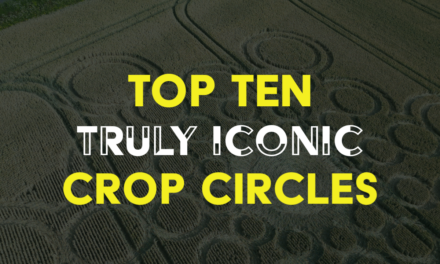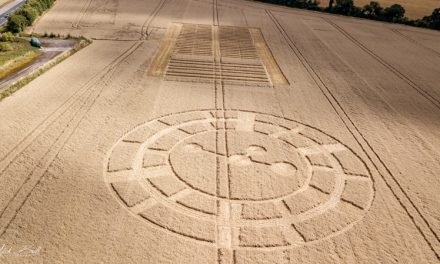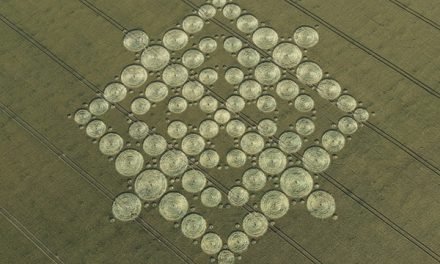
Like 1991 Never Happened: 15 Pieces By Or About Circle Makers and Circle Making

Here at The Croppie we have a straightforward outlook on the role humans play in the crop circle phenomenon: people can make crop circles.
Elsewhere, some would have us believe that everything possible has been done to conceal just what people have achieved in the fields. Even we get accused of this. It’s bullshit, of course. The role of human circle makers has been in the public domain since the 1980s. It has been alleged by John Macnish in Cropcircle Apocalypse that Saint Colin Andrews knew as far back as 1987 that people would head off under the cover of darkness to hit the fields. Not that he shouted about it. But why would one of the biggest names do such a thing?
So, let’s share fifteen pieces concerning circle makers and their work that everyone should read, watch or listen to. Some are produced by the makers themselves, others by third parties with inside access, and a couple by those who probably have never known circle makers but can offer insights into the minds of those who deceive others.
We’ve also thrown in some suggestions for further reading which are well worth checking out.
Working Backstage With the Circles (John Lundberg)
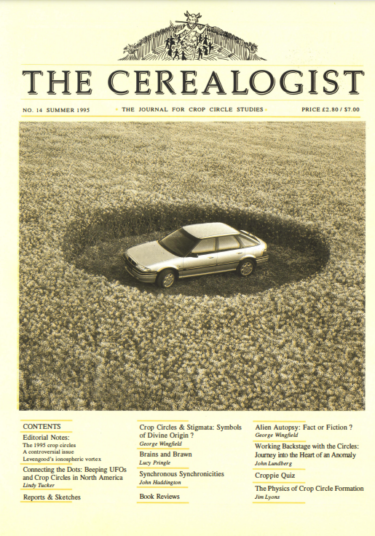
John Lundberg is one of the best known circle makers from the 1990s and opening decade of the 2000s, being a core member of the Circlemakers.org team and co-author of The Field Guide. In this piece for The Cerealogist, he outlines how he first heard of crop circles in 1990 as an artist with a strong interest in the paranormal, through his first adventures in the fields, to a guarded recount of the 1994 season and his encounters with curious ‘all-encompassing bursts of light’.
‘Working Backstage With the Circles’ is very much one man’s tale told at an an early point in his circle making career. Though the perspectives offered in The Field Guide seem more developed, this article provides an entertaining recount of how one man, love him or hate him, can become part of a bigger phenomenon.
Lundberg, John (1995), Working Backstage With the Circles: A Journey Into The Heart of An Anomaly, The Cerealogist, No 14, Summer 1995; available at https://thecroppie.com/wp-content/uploads/2021/01/cereologist14.pdf
See also:
Mike J [pseudonym] (Date unknown) I Was A Teenage Plasma Vortex, available from http://circlemakers.org/vortex.html, cited March 2024. — An amusing tale of how two men’s brief excursion into circle making ended up with their work being shared around the world by the biggest of cerealogical names.
Richardson, Julian, Woodstock, Lee (2012) Crop Circle Maker Interview, available at https://www.youtube.com/watch?v=Ho6te2imJjg, cited March 2024. — This fascinating 2012 interview with veteran circle maker Julian Richardson covers his first forays into making, along with many of the strange and amusing events he experienced in the previous 22 years. There’s also a few snippets in here for the aspiring circle maker as to effective planning. As of January 2025 the interview no longer seems to be available on YouTube.
Circle Makers Speak (The Croppie)
We’re not usually ones to highlight our own work, but The Croppie’s Circle Makers Speak series is the most current entry in this list.
We asked a number of contemporary circle makers for their views and perspectives on croppiedom, together with details of their experiences in the fields. Don’t expect a tell all list of who made what with names and dates (that isn’t a philosophy those circle makers subscribe to), just honest recollections and anecdotes.
In our highly biased opinion, Circle Makers Speak offers the best insight into the world of the otherwise silent modern circle maker who respects the history of the phenomenon and doesn’t crave public adoration.
The Croppie (2024) Circle Makers Speak, available from https://thecroppie.com/category/circle-makers-speak/, cited March 2024.
Trickster (John Roberts)

Originally published within the Oxford Art Journal in 1991, Trickster explores the role of the covert circle maker and their relationship to their audience. It focuses specifically on the work of Rod Dickinson, a now retired maker famous for his involvement with Circlemakers.org, and his goal to ‘rethink crop-circle making as the basis for an enquiry into the conditions of modern mythology’.
It needs to be said that Roberts’ writing isn’t the most accessible — a third party The Croppie is familiar with once hastily dismissed the article as ‘pretentious bollocks’ — but underneath the wordiness there is a lot of good material. Roberts picks up on the relationship between makers and croppies to be co-dependent and symbiotic; the role of the circle maker is to both give the true believer what they want and outmanoeuvre those who believe crop circles can be explained away in mundane terms (the latter being reminiscent of the interplay between Doug Bower and Dave Chorley towards meteorologically inclined cerealogist Terence Meaden):
That [cerealogical] writers are prepared to argue for either the extra-terrestrial or paranormal creation of the circles is not simply perverse, but culturally significant, pointing to needs and desires which modern forms of rationalism cannot meet. … the crop-circles are made with the desires, fantasies and occult knowledges of the ‘true-believers’ in mind. They are not ironic. Thus if the complexity of the recent designs is partly a response to Dickinson’s own technical and aesthetic ambitions, it is also a way of upping the ante in response to the Cerealogists’ theories. This play-off between producer and consumer, mythologizer and believer, is at one level very similar to the practices and rhetorics of art and its theory. In a strange mutation of classic avant-garde practice, Dickinson seeks to outmanoeuvre, or undermine, the claims and expectations of those theories that would seek to explain or predict the crop-circle designs.
Roberts, John (1999) Trickster, Oxford Art Journal, Volume 22, Issue 1, pp. 81–101. Also available at http://www.circlemakers.org/trick.html
Circlemakers (Matthew Williams)
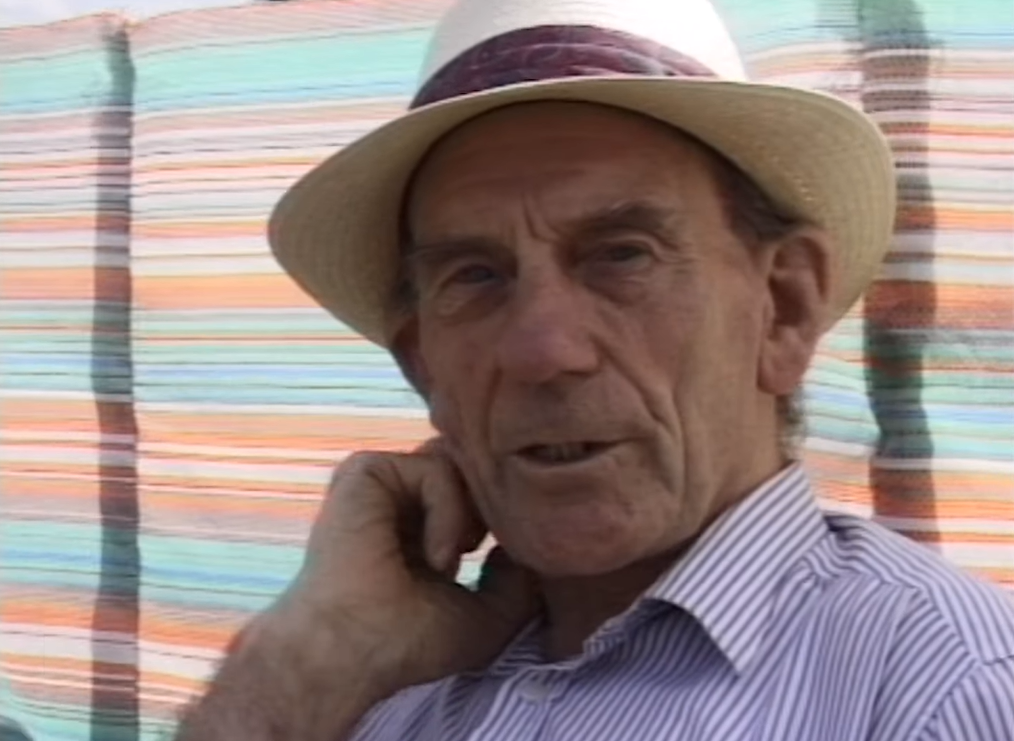
Doug Bower in Circlemakers.
Circlemakers is a three hour marathon of interviews with, surprise surprise, crop circle makers from the past. Some of the footage is Williams’ own, although the best parts are the full interviews conducted with Doug Bower and Rob Irving, both of which were recorded by Grant Wakefield for his endearing Croppies documentary.
A range of opinions and perspectives are on display, including the mysticism of the late Paul Randle and one maker so keen to prove his own abilities he set to recording his designs in encrypted digital files before they were made in the fields.
Best insight comes from Irving who observes, ‘The key to all of this is that people aren’t actually looking for answers. They’re not interested in answers … they’re interested in a social habit … if they were interested in an answer then there would be no reason to come to the Barge every year.’ Cynical? Possibly … though certainly accurate for the time. It’s a train of thought you can extend — rightly or wrongly, some people want to believe in the paranormality of certain things, crop circles included, and will fit the evidence to their beliefs.
Williams would later go on to produce Circlemakers TV, a YouTube show in which makers would do themselves and the wider phenomenon no favours by claiming certain circles as their own. As you can imagine, farmers across Wiltshire were overjoyed.
Williams, Matthew (2002), Circlemakers, available at https://www.youtube.com/watch?v=3OS7_Fn-RzU.
Find the first part of Circlemakers here:
See also:
Wakefield, Grant (1999), Croppies, available at https://www.youtube.com/watch?v=QUTONHyxhB4 — A naughty but charming look at the world of crop circle enthusiasts. Among their number are circle makers. Watch by clicking here.
Hein, Simeon (2002), Opening minds : A Journey of Extraordinary Encounters, Crop Circles, and Resonance, Colorado: Mount Baldy Press — Amongst all sorts of investigation into high strangeness, Hein details his crop circle investigations and the time spent in a field with Matthew Williams. Poor sod.
Men Who Conned The World (Graham Brough)

The ideal place to start reading into the minds of Doug Bower and Dave Chorley, seemingly the original human circle makers, is their tell-all exposé to TODAY newspaper in September 1991.
Spread over three days of material, Graham Brough’s reportage explains why Bower and Chorley became involved with circle making, the basics of how they worked in the field and, most revealing of all, how they interacted with the croppies and cerealogists they encountered.
Brough, Graham (1991) Men Who Conned The World, TODAY, 9 September 1991
Brough, Graham (1991) Night We Thought The Game Was Up, TODAY, 10 September 1991
Brough, Graham (1991) Hoaxers Come Out In The Open, TODAY, 11 September 1991
Find the collated press clippings at: https://thecroppie.com/2020/10/23/documents-men-who-conned-the-world/
The Art Of The Hoax (Rob Irving & Peter Brookesmith)
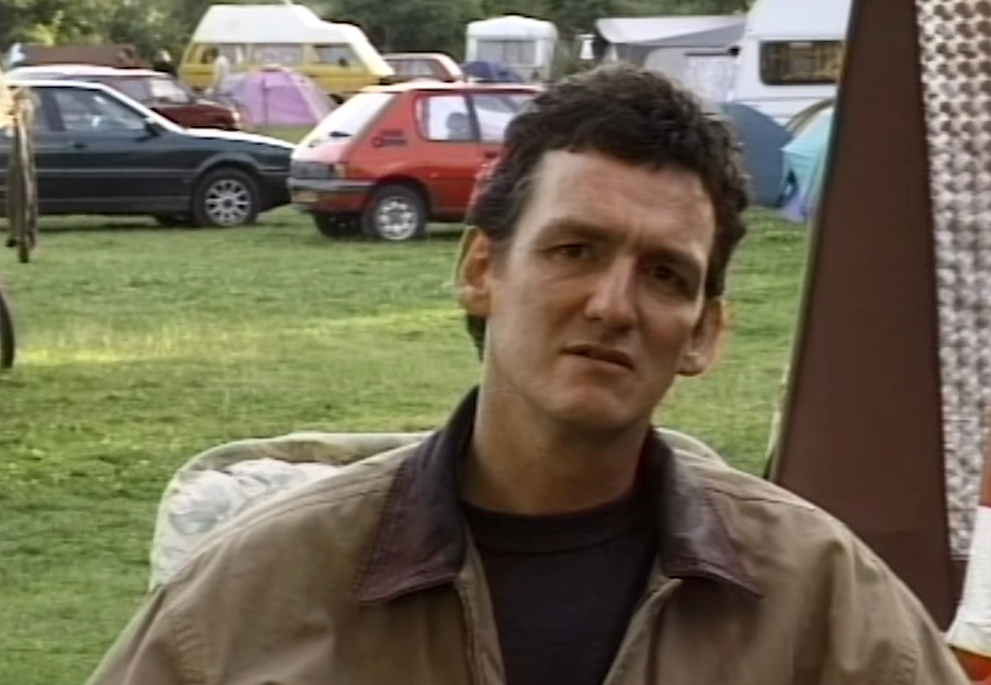
A young Rob Irving.
Crop circles are a lens through which we can explore the nature and appeal of hoaxes. Fakes, counterfeits and forgeries are all around us in the everyday world—from dud $50 bills to spurious Picassos. People’s motives for taking the unreal as real are easily discerned: we trust our currency, and many people would like to own a Picasso. The nebulous world of the anomalous and the paranormal is even richer soil for hoaxers. A large proportion of the population believes in ghosts, angels, UFOs and ET visitations, fairies, psychokinesis and other strange phenomena. These beliefs elude scientific examination and proof. And it’s just such proof that the hoaxer brings to the table for those hungry for evidence that their beliefs are not deluded.
This article co-authored by circle maker Rob Irving has been well thumbed since its publication, but do not let that devalue the neat overview of circle making philosophy it provides. Most notably, the article touches upon the concept of ostension, ‘false evidence intended to corroborate an existing legend’.
Irving, Rob and Brookesmith, Peter (2009) The Art of the Hoax, Smithsonian Magazine; available from https://www.smithsonianmag.com/arts-culture/crop-circles-the-art-of-the-hoax-2524283/, cited March 2024
See also:
Lundberg, John (2003), Ostension.org (archived), available from https://web.archive.org/web/20181225181106/https://ostension.org/, cited March 2024 — An introduction to ostension and its three major forms.
McEwen, John (1991) Crop Circles As Art, The Cerealogist, No 3, Spring 1991 — An incredulous art critic praises the brilliance of the then unknown circle makers of southern England.
Cropcircle Apocalypse (John Macnish)

Television producer John Macnish found himself pulled into the golden era of cerealogy through his involvement with BBC’s Daytime Live show. Initially convinced a mystery lay behind the circles phenomenon, the confessions of Doug Bower and Dave Chorley turned his view on its head. Across the 1992 season, Macnish was tipped off by Doug and Dave as to the locations of their future works. Discreetly, and with their full agreement, Macnish photographed the circle makers at work and convinced himself that their testimony was real. Also featured are Macnish’s trips along the M4 with circle maker Jim Schnabel and details of the young circle making team from the East Midlands.
Macnish, John (1993): Cropcircle Apocalypse, Ludlow: Circlevision
The Circle Making Competition (Christine Rhone and Others)
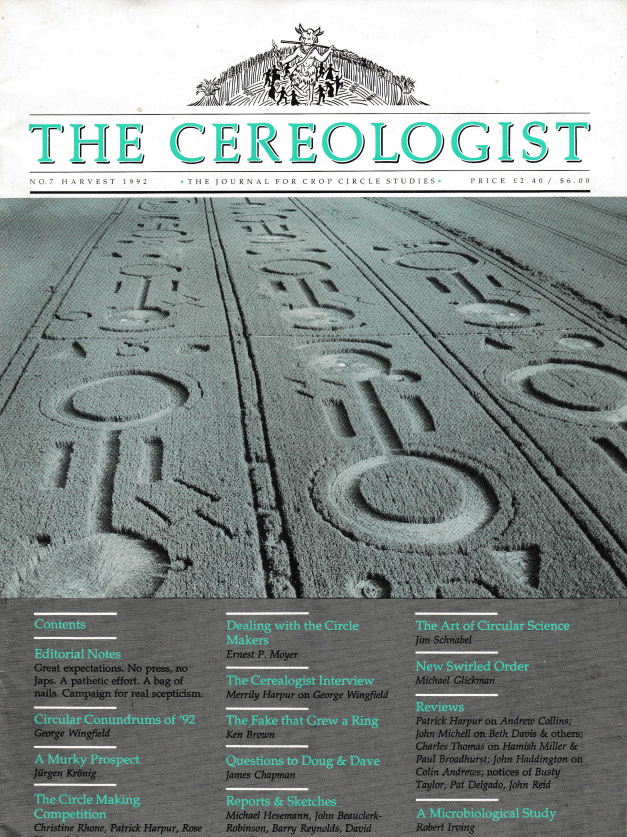
Back in 1993, The Cerealogist held a competition for circle makers to create their own versions of a predetermined formation in a field at West Wycombe in Buckinghamshire. Twelve teams competed against each other in a tussle eventually won by an inexperienced Adrian Dexter and his helpers from Somerset. Name competitors were thin on the ground with notorious figures such as Doug and Dave, the Wessex Skeptics and Rob Irving staying away for their own reasons.
The Circle Making Competition is a compilation of reports from the event, the two major highlights being Patrick Harpur’s recollections of what it’s like to observe circle makers at work in the darkness, and Jurgen Kronig’s overall conclusion. The latter is particularly interesting given Kronig suggest humans can make crop circles good enough to dupe cerealogists. At the same time, Kronig ponders the worth of the competition with relation to what happens ‘in the wild’ at night, For example:
Some of the techniques used to enter the crop without leaving footmarks demand not only skill and practice. The method used by the winners [involving ladders] is most probably too complicated and risky. Adrian Dexter told me that he does not believe hoaxers would use such heavy equipment, because “one would not like to be caught in the act with heavy stuff which one would have to leave behind or carry over long distances.
Overall, such conclusions are what the competition was about in the first place; an opportunity to see circle makers at work and assess their capabilities.
Rhone, Christine; Harpur, Patrick et al (1992), The Circle Making Competition, The Cerealogist, No 7, Harvest 1992, available at https://thecroppie.com/wp-content/uploads/2019/06/cerealogist7.pdf.
The Summer of '91 (Martin Hempstead)
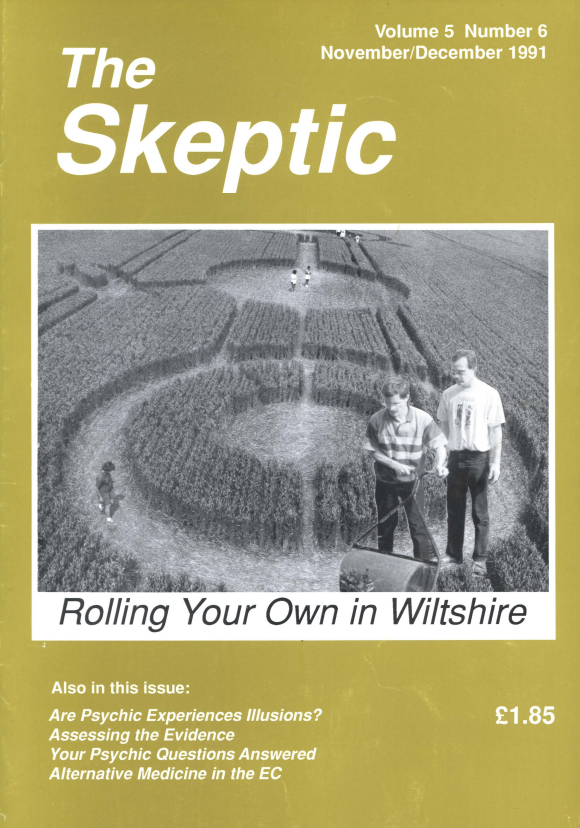
What a peculiarly entertaining pain in the ass the Wessex Skeptics were. As a unit, these opponents of pseudoscience and irrationality ventured into cerealogy to ‘hoax [their] own circles, and see if the experts could tell the difference’ from the ‘genuine’ article. One of the Skeptics’ most vocal members was Martin Hempstead, a forthright academic from Southampton University prepared to fight his corner in any situation.
In his article for The Skeptic magazine, Hempstead explains the views and dubious reasoning employed by some of the biggest cerealogical names of the time. Of more interest to us here is Hempstead’s explanation of how the Wessex Skeptics found their way into the fields during 1991 as a ‘high risk strategy’, the methods they used to make circles and how they were rumbled on their first nocturnal venture. He also touches upon how a circle made by Wessex Skeptics for Channel 4’s cameras was declared by cerealogists Terence Meaden and Busty Taylor to be the real thing.
Overall, Hempstead concludes that ‘mostly, the crop circle experience has just been a bit silly’. This isn’t an unfair assessment and Hempstead’s article is a solid snapshot of a particular circle making mindset towards the end of the golden era.
Hempstead, Martin, The Summer of ‘91, The Skeptic, Vol 5 no. 6, November/December 1991.
See also:
Grassi, Francesco (2017), Crop Circles: Signs of Intelligence by Francesco Grassi, self published — Not our words but we will reproduce them … ‘a reductionist, poor man’s version of The Field Guide written by a skeptic.’ We won’t disagree, but do not let our distaste subtract from the author’s effort and commitment.
The Best Intentions (Chris Kenworthy)

An extremely thought provoking article from 1993 penned by a believer in the ‘genuine’ phenomenon who became a circle maker. In his piece, Kenworthy argues that crop circles made to deceive the public ‘are nothing more than deceptive tramplings’, whereas those made ‘by people with spiritual intent are genuine’.
To support his position, Kenworthy lays out a succession of guidelines that he believes are essential for makers to produce good work. These include a need for total secrecy, working ‘in harmony with nature’ and adopting ‘a higher atmosphere, mood, spirit and intent than the desire to fool people and then claim glory.’
It’s a sign of how old The Best Intentions is that the author suggests a crop circle such as the 1991 ‘mother of all pictograms’ at Barbury Castle is impossible to hoax, but that doesn’t detract from the overall impact of the piece. Kenworthy appreciated the finer points of crop circle making and his thoughts are more than worthy of consideration, though opponents may consider Kenworthy to have written no more than a case in special pleading.
Kenworthy, Chris (1993), The Best Intentions, The Cerealogist, No 11, Winter 1993/4; available at https://thecroppie.com/wp-content/uploads/2021/01/cereologist11.pdf.
The Bythorn Wonder: An Inquiry (Montague Keen)

At the back end of 1993, journalist and psychical researcher Montague Keen was commissioned by the Centre for Crop Circle Studies to investigate the claims of a 19 year old circle maker called Julian Richardson. This awkward teenager averred that he was the creator of the beautiful mandala-type formation at Bythorn, Northamptonshire, in September of that year.
The CCCS convened an inquiry for the end of January 1994, in which Richardson was interviewed in person for his side of the story. His version of events was scrutinised by outspoken, arrogant and obnoxious cerealogist Michael Glickman who was simply not prepared to accept he had been fooled by the work of one young man with a stomper, a surveyors tape and a damaged camera tripod. As Keen noted, ‘The inquiry was odd because the young man was not protesting his innocence of an accusation against him, but proclaiming his guilt in the face of those who mostly believed him innocent of having made the pictogram.’
Keen’s writing explores Richardson’s story and the criticisms levelled at the claimant by those sat across the table. It also offers insight into the driving forces from both parties. Of Richardson, Keen wrote ‘[his] motive in claiming credit was to satisfy his vanity and earn admiration’. However, Keen reached the conclusion that ‘the weight of direct and circumstantial evidence’ favoured Richardson, though the in-house journal of the CCCS was having none of it and chose to overlook Keen’s report. Instead, an abridged version found its way into the public domain though The Cerealogist. This contained a forthright assessment on the way in which the CCCS had conducted itself: ‘For the CCCS, a body with no collective views, and dedicated ostensibly to the objective investigation of the phenomenon, to be seen (through its official journal and elsewhere) to be proclaiming as genuine what the world will be bound to consider a man-made artefact, is bad enough. It can only confirm that the CCCS has departed from any pretence of objectivity’..
The lesson to be taken from the Bythorn affair is simple. A person can claim to have made this or that circle, and have all of the evidence to support their stance. However, to those people who have the paranormality of crop circles deeply embedded in their personal belief system, there is little — if anything — that will make them change their view.
Keen, Montague (1994) The Bythorn Wonder: An Inquiry, The Cerealogist, No 12, Summer 1994; available from https://thecroppie.com/wp-content/uploads/2019/06/cerealogist12.pdf.
Mercurius In The Fields (Patrick Harpur)
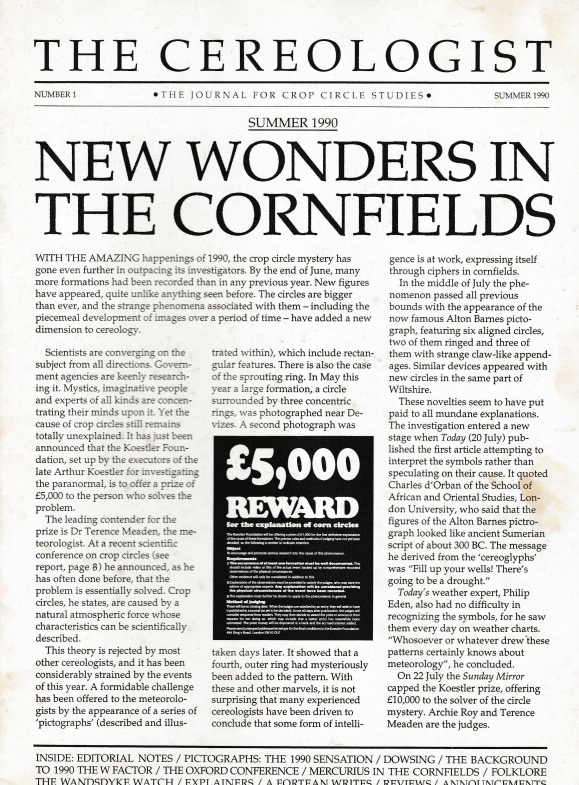
Writing in the very first issue of The Cerealogist (1990), esotericist Patrick Harpur came far closer to the truth of the circles’ origins than any other non-maker at the time ever could have hoped. Rather than argue aliens, plasma vortices and specific plumbers from Devizes were at play in the fields, he instead profiled the circle making force as a trickster. Harpur looked at Mercurius, the Greek god of alchemy for his reference point. This was top notch cerealogical writing in a time of innocence, pre-Doug and Dave, but it remains as relevant as it ever was:
Mercurius is both earth spirit and soul of the world, volatile and fixed. Above and Below, psychic and hylic. He is a trickster, either harmlessly impish or seriously diabolical. His handiwork can be discerned in crop circles which tease us into pursuing him while he maddens us by remaining always just out of reach.
Mercurius is the god of hoaxes. A hoax aims to expose some flaw in society … There is a sinister aspect to all tricksters: they like to play god, or the devil, behind the scenes.
Crop circle[s] are like hoaxes in that they expose our wrong relationship to Nature and mock our methods of investigation. In the end it might not matter if the hoax is perpetrated directly by Mercurius or through the agency of human hoaxers.
Another kind of hoax is the practical joke. It is aimed not at society but at the individual, with the intention of de-intoxicating him from his illusions. In comedy, practical jokes bring self-knowledge to those who have a fantastic idea of themselves. Practical jokers have to unmask themselves in the end and the satisfaction is in seeing the look on the faces of the duped who thought they were acting freely but were really being manipulated all along by the joker.
But what of the joker who does not unmask, like the perpetrator of crop circles? He forces us to unmask ourselves. He needs no satisfaction on the look on our faces. He manipulates for its own sake. He knows us better than we know ourselves. He wants to deflate our self-importance, undermine our principles and beliefs, threaten our reason. He is invisible, ruthless and impersonal, like a psychopath or god. He is Mercurius who, like Lucifer, both deceives in order to destroy and deceives in order to bring light. If we do not know ourselves, that is, know, discern, listen to our daimons — and demons — we are easy prey for the darker side of Mercurius. Let us pray that his tricks stop at crop circles.
Harpur, Patrick (1990), Mercurius In The Fields, The Cerealogist, No 1, Summer 1990; available from https://thecroppie.com/wp-content/uploads/2019/05/cerealogist1.pdf.
See also:
Harpur, Merrily (1992), Lamb, Tiger and Catling, The Cereologist, No 6, Summer 1992; available from https://thecroppie.com/wp-content/uploads/2019/06/cerealogist6.pdf — Circle making viewed as performance art
Harpur, Patrick (1994) Daimonic Reality: A Field Guide To The Otherworld, Washington: Pine Winds Press — Harpur’s theory of everything esoteric draws in crop circles and an overarching cosmic joker.
The Field Guide (Rob Irving & John Lundberg)
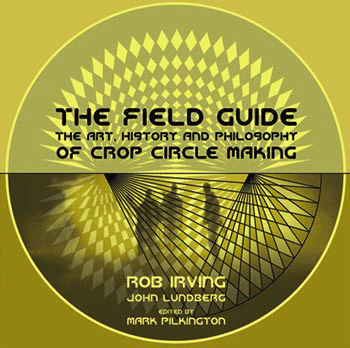
Written by circle makers active in the first decade of the current century, The Field Guide is invaluable for anyone looking to get into the minds of those odd people who go out at night with planks and surveyors tapes. Much of the book covers the history of the circles, but it is not written in chronological order. Rather, it outlines the ongoing interactions between the makers and their audience, whether the latter be the public, cerealogists or sham scientists.
Of course, the book is best known as being the publication that has surpassed any other in guiding modern circle makers as to the practical considerations of their work. All of the DIY instruction on circle making is held within the ‘Roll Your Own’ chapter. Nonetheless, it’s just one part of a fantastic publication that also features interviews with Doug Bower and the authors’ own circle making team. If you take nothing else from The Field Guide it should be this quote from John Lundberg:
What differentiates a crop circle from a piece of land art is an act of perception. There is also the question of authorship. To equate crop circles with art is to undermine their mystery, their resonant significance of something unknown. For a circle to remain ‘genuine’ it must by extension remain authorless. The circles were never intended to be viewed as works of art, but somewhat paradoxically they were made by artists. Drained of their mystery the circles become mere specimens. But circlemaking is undoubtedly a creative act. So we are left with a paradox: The circles are created anonymously by artists, but to be effective they must not be viewed as art.
Irving, Rob and Lundberg, John (2006) The Field Guide: The Art, History and Philosophy of Crop Circle Making, London: Strange Attractor Press
The Trickster & The Paranormal (George Hansen)
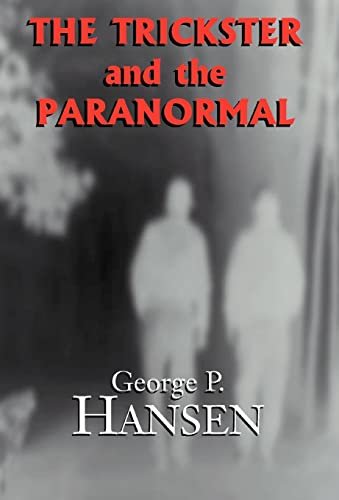
There’s only a sparse scattering of references to crop circles within parapsychologist George Hansen’s book The Trickster and the Paranormal, none of them go into any detail beyond a suggestion that the circles are likely the result of human intervention. Nonetheless, this peculiar, eclectic and category defying text investigates the role of the unpredictable literary trickster as a means to uncover why fraud, deception and the paranormal seem to go hand-in-hand.
Well, what has any of this got to do with crop circle making? Like the maker who lurks in the shadows, archetypal tricksters ‘are messengers and communicators; they deal in information [the provision of crop circles], but also in ambiguity.’
Hansen notes that UFO phenomena — to which crop circles have become closely associated — ‘are fundamentally liminal, interstitial, betwixt and between, and anti-structural. UFOs inhabit the realm between heaven and earth (a binary opposition), much like spirits and angels, and they share common properties with them. In this domain we also find the blurring of imagination and reality, another binary opposition.’ This quote is typical of the entire book. It’s a study of opposites, the grey space between them, and how operating in the latter provides ample opportunities for the trickster to do their thing, whether that be eating their own faeces in the role of a clown (physically, although this can surely apply to the metaphorical), providing positive evidence for the existence of psi, or laying down crop circles. Importantly, Hansen recognises that by carrying out their impish work, tricksters are able to generate paranoia which further muddies the water of paranormal study.
Written in a style that is quasi-academic and sometimes close to impenetrable, The Trickster and the Paranormal is a tough read for the unprepared. In some ways it is reflective of the author, a man who has worked in parapsychology, been derided as a ‘crackpot’, believes in the existence of psi but has worked to bust hoaxes within the ufological community. It’s a book that’s all over the place but offers a transferable insight into the archetype of the trickster and their involvement with all things classified paranormal.
Hansen, George (2001), The Trickster and the Paranormal, Indiana: Xlibris
Round In Circles (Jim Schnabel)
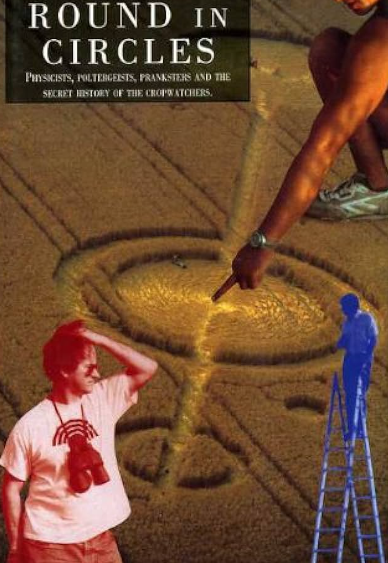
Probably the best book on crop circles ever published, Jim Schnabel’s wry take on cerealogical history and his time spent observing the cropwatchers was unleashed in 1993. We are most concerned with the final chapter and the subsequent brief epilogue. From outlining the testimony of Doug and Dave, Schnabel looks at the activities and motivations of a youthful team of circle makers known as UBI: ‘there seemed among some of the members of UBI to be a sturdy level of belief: that the circles were a sign, a sign of the end. The more an individual could do to hasten this end — by producing chaos, disorder, cosmological confusion, strange signs upon the earth — the more he would earn his place among the chosen.’
Schnabel moves on to admit to bits and bobs from his own circle making CV, including ‘the 200-foot pictogram that appeared on the crest of the hill above Ogbourne St George, like a message from God, with a single pristine grapeshot for signature.’ Whilst we’re not fans of circle makers who shout about what they’ve made, Schnabel grasps how the circle maker is a trickster who can share both truth and fantasy, causing paranoia amongst his audience. He outlines how he duped an investigator sent by cerealogist George Wingfield into believing how he, Schnabel, was part of a global conspiracy involving the CIA and MI6. Furthermore, having laid claim within Round In Circles to the ‘crescent moon shapes, and an alchemical pictogram that a bearded Californian carved into stone and sold for £100’, the Suffolk branch of the Centre for Crop Circle Studies invited Schnabel to replicate what they believed to be the 1992 ‘charm bracelet’ formation at Silbury Hill. Instead, he produced an alternative, leaving more questions behind him than answers.
Following the Suffolk CCCS’s event, Lucy Pringle would later rage, ‘[Schnabel] is a past master at evasion, he is better than any politician I have ever met for side stepping an issue and going off on a lateral tack and when there are a lot of people around, this lateral tack may be very interesting to those people who may not have followed the significance of the original question in the first place. They then get hooked onto the side issue which Schnabel has skilfully engineered and start asking questions about that side issue!’
Schnabel, Jim (1993), Round In Circles: Physicists, Poltergeists, Pranksters and the Secret History of the Cropwatchers, London: Penguin.
See also:
Pringle, Lucy (1993), The Bluffer’s Bluff Is Called, The Cerealogist, No.10, Autumn 1993; available from https://thecroppie.com/wp-content/uploads/2019/06/cerealogist10.pdf — The circles researcher calls out Schnabel for his prevarications.
Schnabel, Jim (date unknown) Genuine Art, available at http://www.circlemakers.org/jim2.html, cited March 2024. — Schnabel ponders the surprisingly tangled relationship between art and science, then laments his lost cerealogical innocence.



